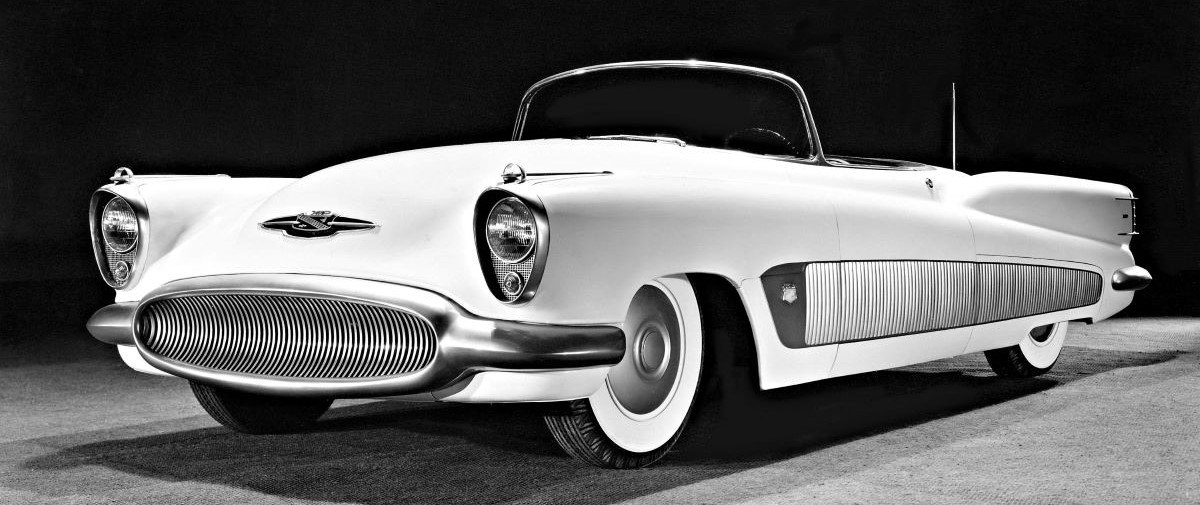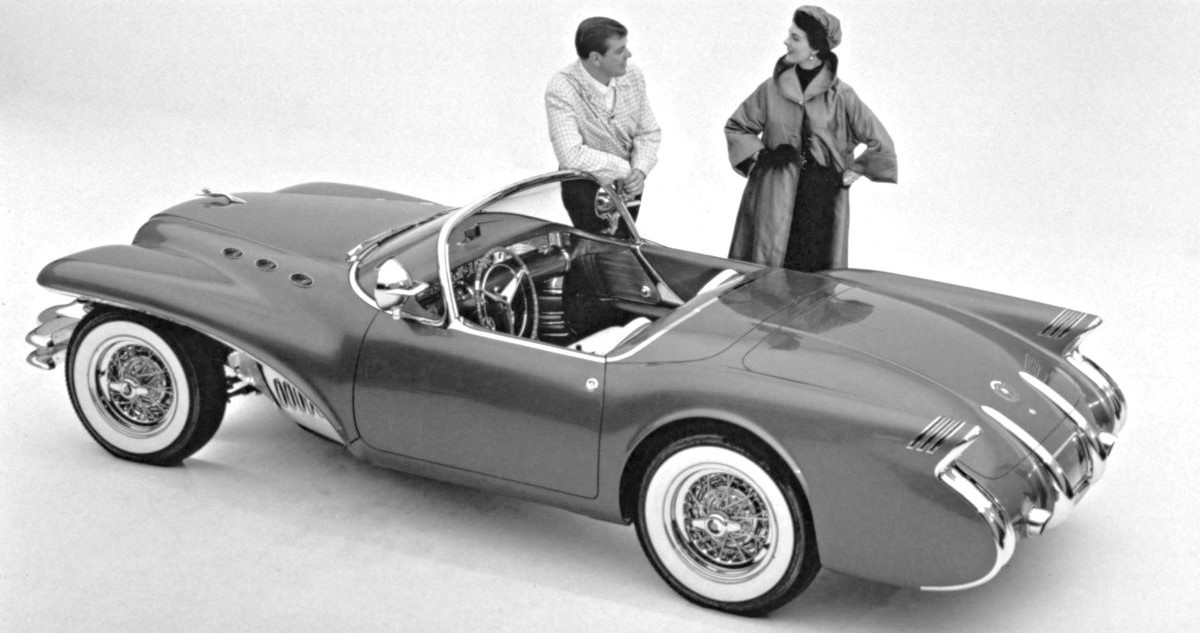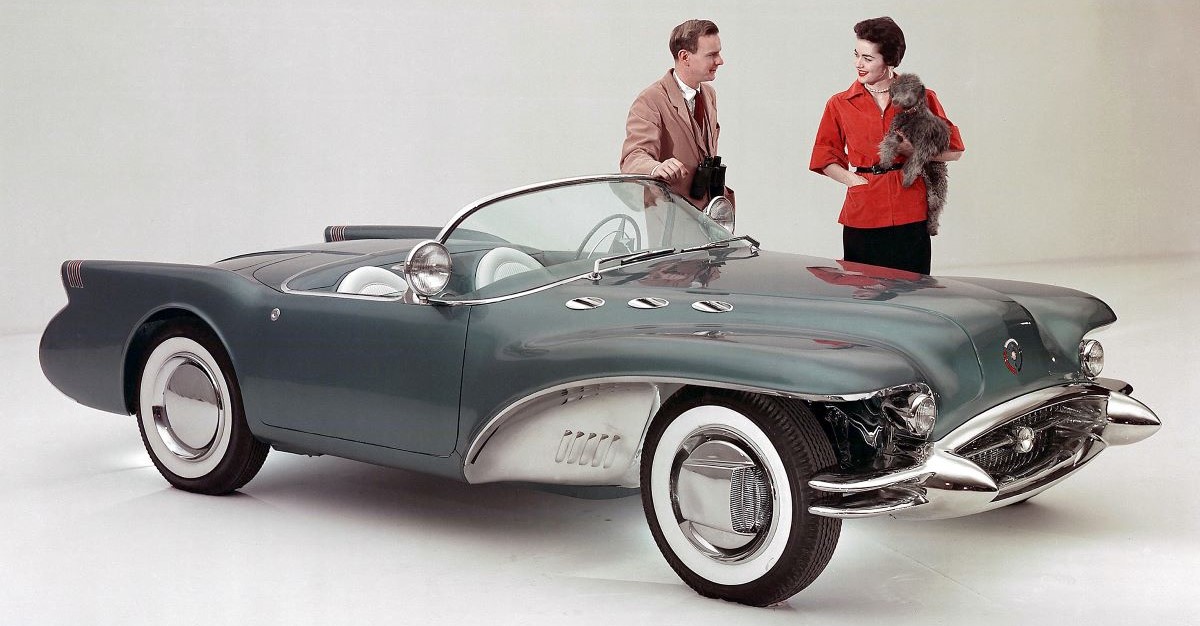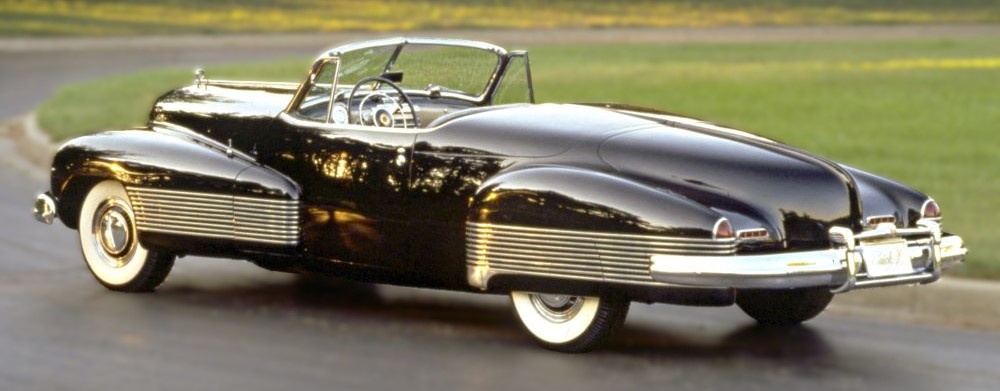
The 1951 Buick XP-300 is a concept car designed by Harley Earl, the head of General Motors’ Art and Color Section. The XP-300 was a highly advanced vehicle for its time, showcasing Buick’s commitment to innovation and futuristic design. It was developed alongside the 1951 GM Le Sabre and shared several design and engineering elements.
Specifications
Engine/Transmission:
- Type: Supercharged aluminum V8
- Displacement: 5.3 liters (215 cubic inches)
- Power Output: Approximately 335 horsepower
- Fuel System:Dual-fuel system capable of running on both gasoline and methanol
- Type: 4-speed automatic transmission
Dimensions:
- Wheelbase: 114 inches
- Length: Approximately 200 inches
- Width: 78 inches
- Height: 51 inches
Chassis and Body:
- Layout: Front-engine, rear-wheel-drive (FR layout)
- Body Style: 2-door convertible with a futuristic, aerodynamic design
- Construction: Lightweight aluminum and magnesium alloy body
Design and Exterior:
- Sleek, low-slung body with a jet-inspired design.
- Wraparound windshield for improved visibility.
- Hidden headlights and a prominent front grille.
- Aircraft-style tailfins and integrated rear bumper.
- Lightweight construction using aluminum and magnesium alloys.
Interior:
- Luxurious and futuristic cabin with advanced instrumentation.
- Leather upholstery with bucket seats designed for comfort and support.
- Aircraft-inspired dashboard with comprehensive gauges and controls.
- Dual-cockpit layout, echoing the design of an aircraft.
Comfort/Convenience/Safety and Innovation:
- Power-operated features, including windows and seats.
- Advanced climate control system for passenger comfort.
- High-fidelity radio and sound system for entertainment.
- Supercharged engine with dual-fuel capability for high performance.
- Advanced suspension system for improved handling and ride comfort.
- High-performance braking system for effective stopping power.
- Reinforced body structure for enhanced safety.
The 1951 Buick XP-300 is celebrated as one of the most innovative and influential concept cars of its time. Designed to explore advanced engineering and futuristic styling, the XP-300 set the stage for many features and design elements that would later be seen in production vehicles. Its aircraft-inspired design, dual-fuel engine, and advanced materials showcased Buick’s forward-thinking approach and commitment to pushing the boundaries of automotive technology.
The XP-300, along with the 1951 GM Le Sabre, highlighted Harley Earl’s vision for the future of automobiles, blending performance, luxury, and cutting-edge design. These concept cars remain significant pieces of automotive history and are remembered for their impact on the design and engineering of future vehicles. The XP-300 is particularly noted for its influence on the styling and technology of the 1950s and beyond, making it a cherished example of mid-20th-century automotive innovation.

The Buick V-8 engine – nicknamed Nailhead for its unique valve arrangement – was introduced in 1953 and powered the Wildcat concept vehicle a year later. Using a quartet of sidedraft carburetors, engineers coaxed 10 percent more horsepower from the engine than regular-production models, giving the Wildcat the power to back up its sporty styling.

The 1954 Buick Wildcat was a concept car that represented Buick’s bold vision for the future of automotive design and technology. As part of Buick’s series of Wildcat concept cars, the 1954 model showcased innovative features and styling cues that influenced the brand’s production vehicles.
Specifications
Engine/Transmission:
- Type: V8
- Displacement: 5.3 liters (322 cubic inches)
- Power Output: Approximately 200 horsepower
- Type: Dynaflow automatic transmission
Chassis and Body:
- Layout: Front-engine, rear-wheel-drive (FR layout)
- Body Style: 2-door convertible with a fiberglass body
Design and Exterior:
- Futuristic, streamlined body design with pronounced curves and a sleek profile.
- Fiberglass construction, which was innovative for the time and reduced the car’s weight.
- Prominent, chrome-laden front grille with vertical bars, a signature Buick design element.
- Unique, quad-headlight configuration set into recessed bezels.
- Wraparound windshield and a low, wide stance to enhance the car’s sporty appearance.
- Tailfins and a sculpted rear end, echoing the jet-age design influences of the era.
- Convertible top with a hard tonneau cover for a sleek look when the top is down.
Interior:
- Luxurious, driver-focused cockpit with high-quality materials.
- Leather upholstery with bucket seats designed for comfort and support.
- Innovative dashboard layout with advanced instrumentation and controls.
- Center console and floor-mounted gear shifter for a sporty feel.
- Stylish, two-tone color scheme to complement the exterior design.
Comfort/Convenience/Safety and Innovation:
- Power-operated windows, seats, and convertible top.
- Advanced climate control system for optimal passenger comfort.
- High-fidelity radio and sound system for entertainment.
- Power steering and power brakes for improved handling and safety.
- Independent front suspension and coil spring rear suspension for a smoother ride.
- Advanced lighting system with high-intensity headlamps and signal lights.
The 1954 Buick Wildcat is remembered as an influential concept car that showcased Buick’s commitment to innovation and design excellence. Its advanced features and futuristic styling elements made it a standout at auto shows and captured the public’s imagination.
Although the Wildcat was not a production vehicle, many of its design cues and technological innovations influenced future Buick models. The use of fiberglass for the body construction, the sleek and aerodynamic design, and the luxurious interior features were ahead of their time and demonstrated Buick’s forward-thinking approach.
The 1954 Wildcat remains a significant piece of automotive history, highlighting the creativity and engineering prowess of Buick during the mid-20th century. It is celebrated by car enthusiasts and collectors for its unique design and the vision it represented for the future of automotive design.

Developed for and debuted at the 1956 Motorama, the Buick Centurion’s futuristic design has been beloved for decades. With many features considered “new” today, this car was certainly ahead of its time. Buick enthusiasts will recognize the “sweep-spear” chrome on the Centurion as being similar to the 1957 Buicks. They might even recognize the rear fins as being like those on the 1959 models. The rest of the car, however, is one of a kind.
The Centurion uses a freestanding speedometer, with a fixed indicator and rotation dial. A television camera, mounted just above the tail cone, projects images from the rear of the car to a screen on the dash, thus eliminating the need for a rear view mirror. Centurion’s “wings,” tail cone, and canopy top reflect the influence that aircraft design had on many of GM’s designers.
- Year: 1956
- Make: Buick
- Model: Centurion, concept car
- Wheelbase: 118″
- Engine: V-8, 348 cubic inches
- Horsepower: 325
- Units Produced: 1

Also see: 1938 Buick Y Job, penned by famed designer Harley Earl, is known today as the first concept car ever created.


You must be logged in to post a comment.